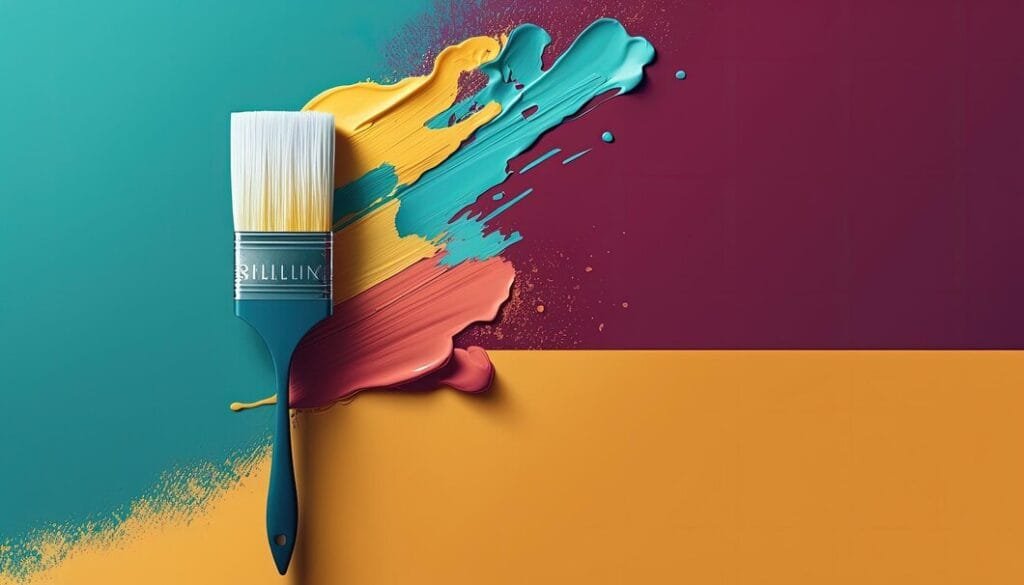Introduction to Texture Paint for Beginners
Texture painting is a captivating method in the realm of visual art that emphasizes the surface attributes of a painting. This technique involves applying varying materials or techniques to create a three-dimensional effect, providing depth and intrigue to artworks. The significance of texture painting extends beyond mere aesthetics; it conveys emotions, invites interaction, and often elicits a deeper response from the viewer. The tactile sensations of a textured surface can transform an ordinary piece into an extraordinary visual experience.
At its core, texture painting enriches the visual language of art, allowing artists to manipulate light and shadow in unique ways. A textured painting can evoke different moods depending on the materials used, ranging from rough, aggressive strokes that suggest chaos, to smooth, flowing surfaces that imply tranquility. Such emotional undertones play a vital role in how a piece is perceived and interpreted, making texture an essential element for artists looking to convey specific feelings through their work.
Various styles of texture painting exist, each offering its distinctive approach to the interplay of materials and surface. For instance, impasto is a popular method where paint is applied thickly, creating a heightened sense of dimension. Alternatively, techniques involving sand, fabric, or mixed media allow for innovative textures that can further engage audiences. Understanding these techniques equips artists, especially beginners, with the knowledge needed to explore their creativity, taking their work to new heights.
In summary, texture painting is an invaluable aspect of artistic expression, transforming how viewers experience and connect with art. By incorporating diverse textures, artists can enhance their work’s visual appeal and emotional resonance, inviting audiences into a deeper exploration of the painted surface.
What are Mithila Paints?
Mithila paints, originating from the Mithila region of Bihar in India, represent an ancient art form characterized by its vibrant colors and intricate designs. This unique style of decorative painting emerged within the rural communities of Mithila, where artists traditionally expressed their cultural identity and narratives through visual storytelling. Mithila paintings are known for their bold hues, predominantly featuring red, yellow, blue, green, and black, which are often derived from natural materials such as plants, minerals, and even cow dung. These colors are not only vivid but also symbolic, encapsulating various aspects of life and culture.
The intricate designs of Mithila art typically include motifs inspired by nature, mythology, and folklore. Artists employ fine lines and meticulous patterns to create lively depictions of indigenous themes, such as animals, birds, and gods. This meticulous attention to detail results in a visual texture that captivates viewers and invites them to delve deeper into the narrative being presented. The cultural significance of Mithila paintings extends beyond aesthetics; they are often used in rituals, weddings, and festivals, symbolizing prosperity and good fortune. Each stroke in a Mithila painting tells a story, making it a profound medium of expression.
In the context of texture painting, Mithila paints offer a unique opportunity to explore the interplay between traditional art and contemporary techniques. Incorporating the distinctive colors and designs of Mithila paintings into texture painting can enhance the overall aesthetic appeal, while providing a rich cultural backdrop. Artists looking to experiment with texture can utilize the natural materials inherent in Mithila art, thereby blending ancient traditions with modern expressions. By understanding the essence of Mithila paints, art enthusiasts can effectively infuse their texture paintings with a touch of history and cultural depth.

Essential Tools and Materials for Texture Painting
Texture painting, especially when utilizing the vibrant and intricate Mithila paints, requires specific tools and materials to achieve the desired outcome. To commence your journey in this artistic endeavor, it is crucial to gather the essential components that will facilitate your creativity and enhance the texture of your artwork.
First and foremost, high-quality brushes are indispensable for any painter. For texture painting, it is advisable to have a variety of brushes on hand, including flat brushes for broad strokes and round brushes for finer detail work. This diversity enables artists to create various patterns and textures. In addition to brushes, palette knives are vital tools that allow for the application of paint in a thicker consistency, thereby creating a three-dimensional effect on the canvas.
Sponges also play a significant role in texture painting. They can be used to apply paint in a stippling manner or to blend colors softly, which adds depth to the artwork. Likewise, special texture tools such as combs, scrapers, or even homemade tools can create stunning effects by manipulating the paint once applied.
Selecting quality Mithila paints is crucial for achieving the best results. These paints are known for their brilliance and adherence to surfaces, making them ideal for texture work. When acquiring Mithila paints, it is vital to look for products that boast rich pigmentation and a smooth consistency, as this will aid in the overall application process. Additionally, it’s advisable to consider complementary mediums such as gels or pastes that can further enhance the texture and dimensional aspects of your artwork.
In conclusion, equipping yourself with the appropriate tools and high-quality materials is fundamental to a successful texture painting experience with Mithila paints. By carefully selecting brushes, knives, sponges, and complementary mediums, beginners can confidently embark on their artistic journey, ready to explore the vivid world of texture painting.

Techniques for Creating Texture with Mithila Paints
Creating texture with Mithila paints can elevate your artwork to new levels, offering depth and visual interest. There are several techniques that beginners can utilize, including layering, scraping, and stippling. Each method presents its unique way of adding texture to your canvas.
Layering is one of the most common techniques in Mithila painting. This method involves applying multiple coats of paint, allowing each layer to dry before adding the next. Beginners should start with a base layer, typically a lighter shade, and gradually build up darker, more complex colors. As layers are added, the colors can interact, producing a rich, textured effect. An effective way to achieve this is by using brushes with different bristle types to create varied strokes and density. Additionally, utilizing tonal contrasts between layers can enhance the three-dimensional appearance.
Scraping is another technique that can produce interesting textures in Mithila art. It involves applying a thick layer of paint and then using a blunt tool, like a palette knife or the back of a brush, to scrape away portions of the paint to reveal the underlying layers or the surface beneath. This not only adds texture but also creates a dynamic visual by exposing various colors and patterns. Beginners should practice this method with different amounts of pressure to see how it affects the texture and lines produced.
Stippling utilizes small dots of paint to create texture and depth. This technique can be achieved with either a fine brush or a sponge. When applying paint, aim to work in layers, gradually building density. Each dot contributes to the overall texture, offering a tactile quality to the artwork. Beginners should experiment with varying sizes and spacing between the dots to see how it influences the overall effect.
Each of these techniques will allow beginners to explore the unique qualities of Mithila paints, leading to personalized and vibrant textures. By practicing these methods, one can effectively incorporate texture into their artwork, making it both visually appealing and engaging.
Color Theory in Texture Painting
Color theory plays a pivotal role in the realm of texture painting, significantly affecting not only the aesthetic appearance but also the emotional response elicited by a painted piece. For beginners using Mithila paints, understanding color theory is essential in choosing the right color palettes that enhance their artwork. It is fundamental to grasp the concept of color harmony, which refers to the pleasing arrangement of colors that creates a cohesive look. By selecting colors that complement or contrast with one another, artists can effectively enhance the perception of textures.
The choice between complementary and contrasting colors can dramatically influence the visual impact of a texture painting. Complementary colors, situated opposite each other on the color wheel, can create vibrant visual interactions when placed side by side, enhancing the appearance of texture. Conversely, contrasting colors can emphasize the texture’s dimensionality, guiding the viewer’s eye throughout the artwork. The judicious application of these color combinations not only highlights the texture but also imparts depth and interest to the overall composition.
In addition to the visual properties, colors carry emotional implications that can influence the viewer’s response. For instance, warm colors like reds and yellows can evoke feelings of warmth and energy, while cool colors, such as blues and greens, often convey tranquility and calmness. Choosing a color palette that articulates the intended emotion can elevate the piece’s significance and help convey the artist’s message more effectively. Moreover, mastering color mixing techniques is crucial for beginners. By experimenting with different combinations, artists can discover unique shades that resonate with their artistic vision while using Mithila paints.
By applying these principles of color theory, artists can create captivating texture paintings that not only appeal aesthetically but also resonate on an emotional level, inspiring deeper connections with the audience.
Creating Your First Texture Painting: Step-by-Step Guide
Embarking on your journey to create a texture painting can be an exciting and fulfilling endeavor, especially when using the vibrant Mithila paints, known for their intricate designs and rich colors. Below, we outline a step-by-step guide that will walk you through the process of creating your first texture painting.
Start by gathering all necessary materials. You will need Mithila paints, a canvas or thick paper, modeling paste or texture medium, palette knives, brushes, and water for cleaning. It’s also helpful to have reference images to inspire your design. Planning is crucial; take some time to sketch your intended composition lightly on your canvas. This sketch will serve as a guide while you apply your textures.
Next, prepare your texture medium. If you are using modeling paste, apply it onto your canvas with a palette knife to create dimensional effects. Consider varying the thickness across different areas to enhance the overall texture. Once you are satisfied with your initial texture layer, allow it to dry completely before moving on to the painting phase.
With your textured base ready, it’s time to introduce the Mithila paints. Begin by mixing colors on your palette to achieve the desired hues. Use brushes or even your fingers for a more organic application, ensuring that you allow some of the texture to show through. Mithila art often incorporates fine detailing; consider using fine brushes to paint intricate patterns or motifs over your textured background.
As you reach the final stages of your creation, contemplate additional elements that may enhance your artwork. Adjust the colors or add layers of paint to create depth. Once you are pleased with your painting, let it dry thoroughly. Finally, consider applying a protective top coat to preserve your textured masterpiece.
Following these steps will not only help you in creating your first texture painting but also instill confidence in using Mithila paints and techniques in future projects.

Common Mistakes to Avoid
Embarking on a journey into texture painting, particularly with Mithila paints, can be an exciting but challenging endeavor. Beginners often encounter several pitfalls that can hinder their progress and affect the overall quality of their artwork. Understanding these common mistakes can greatly enhance the painting experience and results.
One of the prevalent mistakes is improper paint application. Many beginners tend to apply the paint too thickly, which can lead to a muddied appearance and decreased vibrancy. It is crucial to start with a thin layer, gradually building up texture rather than overwhelming the surface. Using tools such as brushes, spatulas, or even fingers can help create varied textures, but control over the amount of paint is essential for achieving desired effects.
Another significant error involves poor color choices. The choice of colors plays a vital role in texture painting as it can affect the mood and impact of the piece. Beginners may often rely on colors they are comfortable with, which can result in a flat composition. Instead, they should experiment with contrasting colors and complementary shades to add depth and interest to their work. Creating a color palette beforehand can lead to more cohesive and striking pieces.
Overuse of textures is another trap that novice painters fall into. While textures can enhance a painting significantly, too many textures can create visual chaos. It is important to strike a balance and use textures purposefully. Focusing on key areas to emphasize texture can draw viewers’ attention effectively, creating a more engaging overall piece.
By being aware of these common missteps, beginners can improve their texture painting skills with Mithila paints, leading to a more fulfilling and successful creative process. Keeping these strategies in mind will aid in avoiding frustrations and achieving more polished results.
Showcasing Your Texture Painting
Once you have completed your texture painting using Mithila paints, the next pivotal step involves showcasing your artwork effectively. The manner in which you display your finished piece can greatly influence its perception and appreciation. One popular method is framing. Selecting an appropriate frame not only enhances the aesthetics of your artwork but also protects it from dust and damage, ensuring its longevity. Consider choosing a frame that complements the colors and textures of your Mithila painting, thereby drawing viewers’ attention to its intricate details.
In addition to traditional framing, you might explore other display options such as canvas mounts or shadow boxes for a more dimensional effect. These presentations can add depth to your work, making it stand out even more. If you have a series of paintings, curating a portfolio collection can provide a cohesive view of your artistic journey. This approach invites viewers to appreciate the evolution of your style and technique over time.
Furthermore, in today’s digital age, sharing your artwork through social media platforms is crucial for reaching a broader audience. Digital formats allow artists to connect with art enthusiasts, potential buyers, and fellow creators worldwide. When showcasing your texture paintings online, high-quality photographs are paramount. To ensure that your artwork looks its best in digital format, invest time in proper lighting and composition. Natural light can accentuate the textural qualities of your Mithila paintings, making them more visually captivating.
When photographing, shoot at various angles to capture the unique aspects of the texture. Editing software can assist in enhancing the colors without altering the original artwork. Sharing your art online can open up new opportunities and inspire others, making the effort worthwhile. Ultimately, effective showcasing of your texture paintings, whether physically or digitally, amplifies their reach and impact within the art community.
Conclusion and Inspiration for Future Projects
As we conclude this guide on texture painting with Mithila paints, it is essential to reflect on the valuable techniques and insights shared. Texture painting not only enhances the aesthetic appeal of your artwork but also allows you to express your individuality and creativity. By following the steps discussed, such as preparing your surface, applying texture mediums, and using Mithila-inspired color palettes and patterns, you are well-equipped to embark on your texture painting journey.
For those looking to expand their artistic horizons, numerous themes and project ideas await exploration. Consider incorporating nature-inspired motifs that resonate with Mithila art, such as flora and fauna. This can be an excellent way to practice blending colors and creating intricate patterns. Additionally, you might explore abstract concepts, where texture plays a pivotal role in conveying emotion and movement within your artwork. The beauty of texture painting is that it invites experimentation; thus, do not hesitate to play with different materials like fabric, beads, or scrap papers to create unique textures.
Another pathway for growth in your artistic endeavor is to collaborate with fellow artists or participate in community workshops. Sharing ideas and techniques not only fosters a supportive environment but also opens the door to new perspectives and inspiration. Remember, every brush stroke is a step towards mastering your craft, and there is always room for improvement.
Ultimately, texture painting with Mithila paints embodies the joy of personal expression in art. Each creation is a reflection of your journey, showcasing your evolution as an artist. Embrace every experiment, enjoy the process, and let your imagination run wild as you continue to explore the vibrant world of texture painting.


